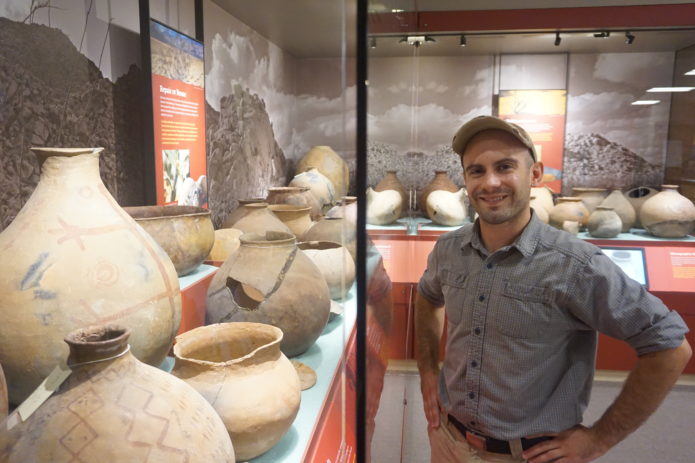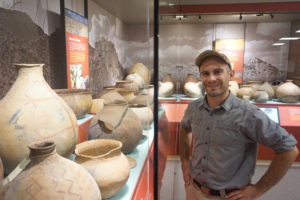
Dr. David Breeckner, Executive Director of the Imperial Valley Desert Museum, is pictured in front of a collection of pottery and other artifacts from the native cultures that have resided in the Yuha Desert for some 10,000 years. The museum, located off Interstate 8 in Ocotillo, is open to the public 10 a.m. to 4 p.m. Wednesday through Sunday. For more information about the museum, see its website, www.ivdesertmuseum.org or call 760.358.7016.
In the far western corner of the Imperial Valley, nestled among the wild Ocotillo plants and rugged desert landscape, is a towering bronze sculpture known as the “Spirit of the Desert” depicting the native cultures of the Yuha Desert.
The sculpture welcomes visitors to the Imperial Valley Desert Museum, a modern interactive museum in the heart of the desert that tells the story of the cultures that have thrived in this extreme desert environment for thousands of years.
Walk through the museum entrance, and visitors are first greeted by a 360-degree screen that displays images of the surrounding desert. At the user’s touch, they can zero in on the jagged mountain peaks, arroyos and valleys that make up the unique, historical desert environment.
The Imperial Valley Desert Museum celebrates the long history of the Yuha Desert and the native cultures, like the Kumeyaay and Quechan Indian tribes, that still call this desert home just as their ancestors did.
The museum, located off Interstate 8 in the remote community of Ocotillo, opened its doors in 2012 as the fulfillment of a dream to preserve and honor the region’s history.
“We are creating an active engagement and conversation,” said Dr. David Breeckner, the museum’s new Executive Director. “That is what modern museums do. We are imparting a new perspective, and we are challenging you to become more than you are by expanding your knowledge, and we do that through our collections.”
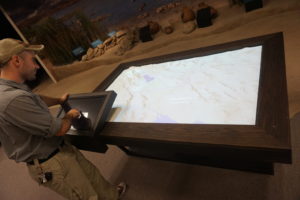
An interactive display at the Imperial Valley Desert Museum shows how the Valley was once under the ocean, then as the waters receded, the ancient Lake Cahuilla formed. The display also shows how the basin would fill with water and then dry over its history until the most recent body of water — the Salton Sea — formed.
Inside the museum where the interior is designed to match the desert environment, visitors find displays that showcase the archaeology of the desert, tell the story of the importance of water to the native cultures, and build an awareness of the area’s geology.
In the background, bird songs sung by local members of the Kumeyaay play softly and videos feature the native cultures discussing their way of life.
One interactive display shows how the Valley was once under the ocean and how, as the waters receded, the ancient Lake Cahuilla formed. The display goes on to show how throughout history the lake has formed and dried—eventually becoming the current Salton Sea.
Near that display is a wall that showcases the stacked rocks used as fishing traps by the native cultures along the shores of Lake Cahuilla. Today, those ancient traps still line the hills along Highway 78 between Imperial and Riverside counties.
Other parts of the museum showcase the native pottery, weapons, tools and headdresses of the cultures that have resided here for thousands of years. All of the collections have been found in the surrounding desert and mountains, and are the result of active archaeology and donated family collections.
For Breeckner, the pottery is especially important, both because pottery was the focus of his own studies in the field of archaeology and because of what can be learned from such discoveries.
“To me, pottery is one of the most important pieces of material culture,” he said. “You can learn so much about the people—where they lived, what they knew technically and technologically, their aesthetic values, and what they were doing, and who they were talking to.”
Not only do the displays inside the museum tell the story of the native cultures, hiking trails around the museum further build an understanding of the desert and how people could survive in the environment.
At the top of a wash just beyond the museum, hidden by time among the bronzed rocks and the Ocotillo plants, is an ancient geoglyph of a snake that stretches from the museum grounds, across the interstate deeper into the desert. Very little of it is visible, but a close look reveals the tail of the snake. Such geoglyphs were a way for the native cultures to share their religious beliefs.
“This museum depicts the history of the landscape that surrounds us,” Breeckner said, adding: “We are expanding your view, and showing that you are part of this history.”
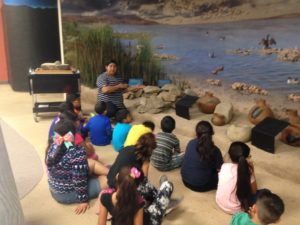
Students from a local school learn about how the native cultures used rocks to form fish traps as a way to gather food during a field trip at the Imperial Valley Desert Museum.
When the museum opened in 2012, it came about following a long fund-raising effort by community leaders.
The vision for the museum dates back years before the opening.
An earlier version of the desert museum, dating back to the 1970s, was housed in a building in El Centro on Main Street and was operated as part of Imperial Valley College. The late Jay Von Werlhof, who was a renowned archaeologist for his study of native culture, led the museum at the time.
An earthquake in 1979 damaged the building, leaving it unusable. But Werlhof and community supporters of the museum had a dream for something grander—a museum facility that would be built in the desert environment to celebrate the native cultures.
The dream was to not only share the story of their history but to honor those cultures that are still very much a part of the Yuha Desert environment.
In 1987, the federal government granted the land upon which the museum would be built. Werlhof and his supporters, with backing from Imperial Valley College, launched their campaign to build the facility. They succeeded in 2008. However, it would take another four years to raise the funding to open the museum.
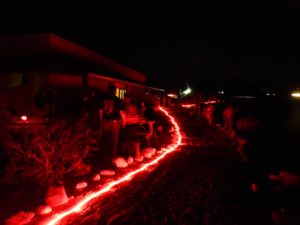
During the year, the Imperial Valley Desert Museum holds stargazing events, which are attended by hundreds of Imperial Valley and San Diego residents.
Though Werlhof lived to see the museum facility built, he passed away in 2009 at the age of 86. It would take the efforts of Dr. Neal Hitch, who served as executive director of the museum from 2012 to January of this year, to finally see the museum open its doors.
“Under Neal’s guidance, we were able to make it a proper museum,” Breeckner said. “We were able to display the artifacts and bring people in. He took it from ‘the museum that never opened,” and made it an institution in its community.”
Under Hitch, the museum also started to garner national recognition at conferences as both a museum and research facility—one where those seeking a professional career in history, archaeology, and museum curating can expand their educational and professional experiences. The museum currently works with San Diego State University on an internship program, and is looking to expand the program.
The museum has also become an educational resource for local schools, offering both field trips and classroom presentations. Museum staff will travel to schools as part of the “History on the Go” program.
It now falls on Breeckner and his staff to continue the efforts Hitch began, and to continue to seek endowment funds and community funding to expand the work of the museum. In fact, a big part of Breeckner’s work focuses on fund-raising. The museum currently operates under a National Endowment for the Humanities Challenge grant but must provide matching funds annually, which means seeking community support.

Dr. David Breeckner kneels beside an ancient geoglyph of a snake located in the desert just outside the Imperial Valley Desert Museum.
So far, the community has risen to the challenge thanks, in large part, to the backing of the Imperial Valley Desert Museum Society, the non-profit organizational arm of the museum. Volunteer support has also been crucial to the success of the museum.
But Breeckner wants to see the museum continue to grow in the area of research and to expand its services to the region, so the search for funding and community support will continue to be his critical role.
Breeckner’s own journey to the museum is as unique as the desert environment he now calls home. A native of Connecticut, he grew up getting his hands dirty exploring the forests around his home, and saw his father’s passion for history through his love for the History Channel.
He graduated high school in 2005 and earned his bachelor’s degree in the Classics from Saint Michael’s College in Vermont in 2009. His degree focused on the study of ancient Greek and Roman literature.
Breeckner then traveled to Ireland to study for his master’s degree in the Classics and Archaeology at Trinity College Dublin. He earned his master’s in 2011 and immediately began work on his doctorate, which included a focus on pottery and led him to frequent digs at ancient sites in the Mediterranean on the island of Crete.
He moved back to the U.S. in 2014 where he continued work on his doctorate and began a career as a university professor. Though his goal originally was to be a professor, he quickly learned that his time in the field had split his passion.
“I wanted to make an actual input into the research,” he said. “I didn’t want to be a professional digger, so a curator was the obvious choice. It is a way of sharing your passion with the public.”
While researching positions, he found an opening for a curatorial fellowship at the Imperial Valley Desert Museum. The ad for the position stated that the candidate chosen would be living in an extreme environment where they could hike, experience incredible desert resources, and make a big impact in the community.
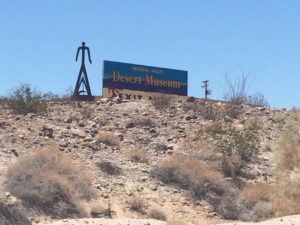
Pictured is the bronzed sculpture, “Spirit of the Desert,” which represents the native cultures of the Yuha Desert. The sculpture stands next to the sign welcoming visitors to the Imperial Valley Desert Museum.
Breeckner sought the position and started in 2017, shortly after earning his doctorate. The initial contract, which had him serve as lead Curator, was for three months. After that initial time, his contract was extended. However, shortly after that, Hitch accepted a position in a museum in Hawaii, and Breeckner was named the museum’s interim Executive Director.
As of July, he was named the permanent director.
“I love it here,” he said, speaking of both the desert environment and the museum. “We have the freedom to do things here that other institutions cannot. We have the freedom here to innovate and implement programs in ways other institutions cannot.”
Community partnerships are an example of that. In one case, the museum has partnered with the Imperial County Probation Department in a program that has young people working at the museum, learning under an educational curriculum, but also engaging with the museum staff “as equals” on projects.
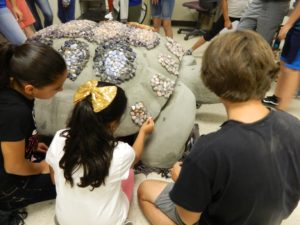
Students decorate a ceramic turtle with colorful rocks as part of an art project during a field trip to the Imperial Valley Desert Museum.
Breeckner is also excited about a new program at the museum meant to teach kids about cultivation and propagation while helping the Salton Sea. Over the next three years, the museum—with the help of students from area schools—will be growing brittle bush plants and once they reach maturity, they’ll be transplanted to the shoreline of the sea with the concept the plants will spread and cover playa.
“This is a way we can make a difference at the sea,” he said.
The museum is also trying to engage with communities through a series of special events. Through the year, the museum will hold stargazing, craft, archaeology, and rock exploration events, as well as launch a new beginner’s hiking program this fall. On July 21, the museum will hold a water day to teach about the importance of water in the desert.
“We want to provide cultural and educational events you do not have in the Valley,” he said.
Going forward, Breeckner said the focus will be on continuing to engage with the native cultures to help tell their story, and to reach out to the region to ensure they understand how important the museum is as a resource.
Breeckner finished with a quote from Hitch, the former Executive Director. “Give us 20 minutes; we’ll give you 10,000 years.”
